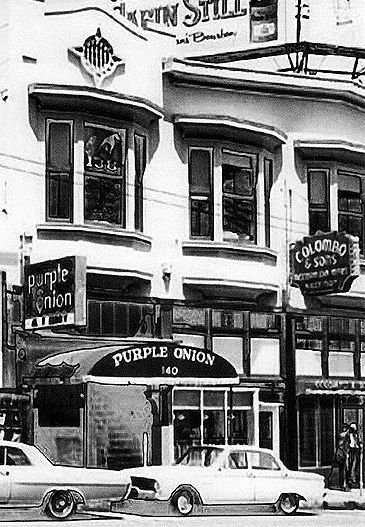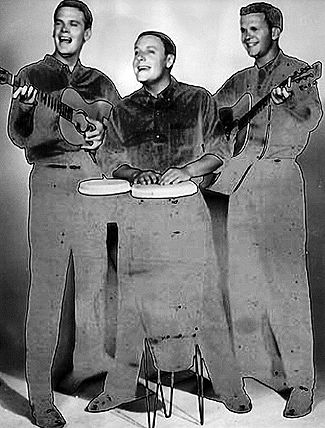Purple Onion
Historical Essay
This article originally appeared in The Semaphore #200, Fall 2012 under the title "The Onion That Was"
By Art Peterson
They say you’ve made it big time when you become a clue in the New York Times crossword puzzle. If so, the Purple Onion Comedy Club, which closed its door on September 28, 2012 after nearly 60 years in business, has received appropriate recognition. A clue from the Aug., 23, 2011 puzzle read “Legendary S.F. music/comedy club where Woody Allen and Lenny Bruce performed.” Answer: Purple Onion. But the puzzle maker was a little off. The Onion, located at 140 Columbus between Jackson and Pacific streets, is indeed a legend, but Allen performed mostly at the Hungry i across the street where, according to Chronicle Entertainment Critic Joel Selvin “nobody knew [him].” Bruce, according to Selvin, played Basin Street West as well as Off Broadway and Ann’s 440 club, “but any appearance at the Onion must have been pretty shadowy.”

The blogosphere also makes mention of Onion performances by Richard Pryor, Jonathan Winters, Barbra Streisand and others, who are said to have descended 16 steps to the 80-seat intimate cave of a club. None of these performers, however, is mentioned in a 1978 Examiner interview with Bud and Virginia Steinoff, who along with Keith Rockwell founded the club in 1953. Instead, as Selvin says, the Onion was “mostly a place where up-and-coming and unknown talent played.”
Perhaps the most unknown of these was a 37-year-old Alameda housewife and mother of five, Phyllis Diller, whose husband talked her into trying out at one of the Onion’s regular Saturday afternoon auditions. Almost against their better judgment, Rockwell and the Steinoffs hired Diller. “None of us thought she was very funny,” said Virginia Steinoff. The managers soon fired her. Yet Diller won another chance because of her positive attitude. “She would never blame the audience the way many other comedians do. It was always, ‘what did I do wrong,’" said Virginia. Developing an onstage persona that “Tonight Show’’ host Jack Paar later described as “that person you try to avoid in the supermarket,” Diller went on to perform for a record breaking 87 weeks in 1957.

When Diller needed an opening act, the managers hired — after four auditions — the group known as the Kingston Trio. As local boys from Palo Alto, the trio had a long mailing list of local fans and acquaintances who soon began filling the club. Their métier was to draw on old folk songs such as “Tom Dooley.” “We started paying them $300 a week,” said Bud Steinoff. When Tom Dooley, promoted by a Salt Lake City disc jockey, sold 3 million copies, the trio was in a position to command a lot more salary. For their second album, they abandoned ship and went across the street to record, “The Kingston Trio from the Hungry I,” a venue that was becoming nationally famous. Loyalty then brought them back to the Onion for one more gig.
A few years later, another group was propelled to fame by an album, this time recorded at the Onion. It was “The Smothers Brothers at the Purple Onion,” the duo mixed a folk-song repertoire with humor that depended often on a mock sibling rivalry. “Oh yeah, well, mom always liked you best,” a line guaranteed to somehow make a 1950s audience crack up. One day a television scout from the Tonight Show approached the duo. “We’d like to use you,” he said, and the brothers went on to perform almost 50 times on that program, which, of course, led to their own edgy variety show. As the fame of the brothers increased, the Onion offered them $2,000 a week in 1965. “Sorry, ‘we make that in a night,’" they said. “That was the last we saw of them,” Bud Steinoff said.
The Onion hosted many other memorable persons and moments. In 1954, 25-year-old Maya Angelou got a gig there as a folk singer. The Chronicle raved about her “deep untrained, vibrant singing voice” — and her beauty. Another future poet of sorts, Rod McKuen, was hired at the Onion. “He didn’t sing very well, but all the women wanted to take him home,” said Virginia. Bud Steinoff told of how he sometimes would get too busy bartending to fulfill his role in Jim Nabors’ act. “Jim would hit a very high note and I was supposed to break a glass behind the bar. Sometimes I’d get distracted and miss my cue,” which, in a way, might have been funnier.
By the 1970s, North Beach as a center of live music and comedy had given way to the Topless. Virginia said, “We and Finnochio’s were the only ones left, and we depended on the tour-bus crowd to fill the club.” She did not see these visitors as ideal clientele. “They’d hold on to their drinks the whole show and will break your arm if you try to take it.” The plucky club survived for a few years boasting a marquee that read simply “No Topless.”
By the 1980s, the Onion had transformed into a garage-band rock club, featuring such bands as the Groovy Ghoolies and the Trashwomen. The club was not helped by a 1990 gang shooting outside its doors that killed one and wounded 11.
In 2004, when Mario Ascone, who runs the Café Macaroni upstairs, took over the Onion it returned to its comedy roots. Mort Sahl did a couple of shows there in 2005 and Robin Williams would sometimes drop by. In recent years, the Onion has been primarily a venue for aspiring young comics, who managed social media to attract weekend crowds. The fledgling performers seemed to appreciate working at this venerable location. Said one: “I’m walking in the bowels of comedic history, entering a time where night clubs had table cloths, patrons sipped highballs and comedians wore suits.”
With the sale of the location that includes the Onion, Cafe Marconi and the 48-year-old Salio’s barber shop, the new use for the site is uncertain. Rumor has it that the buyer is Roger Forbes, owner of the strip club conglomerate, Déjà Vu. Do you think anyone can locate that “No Topless” sign?
